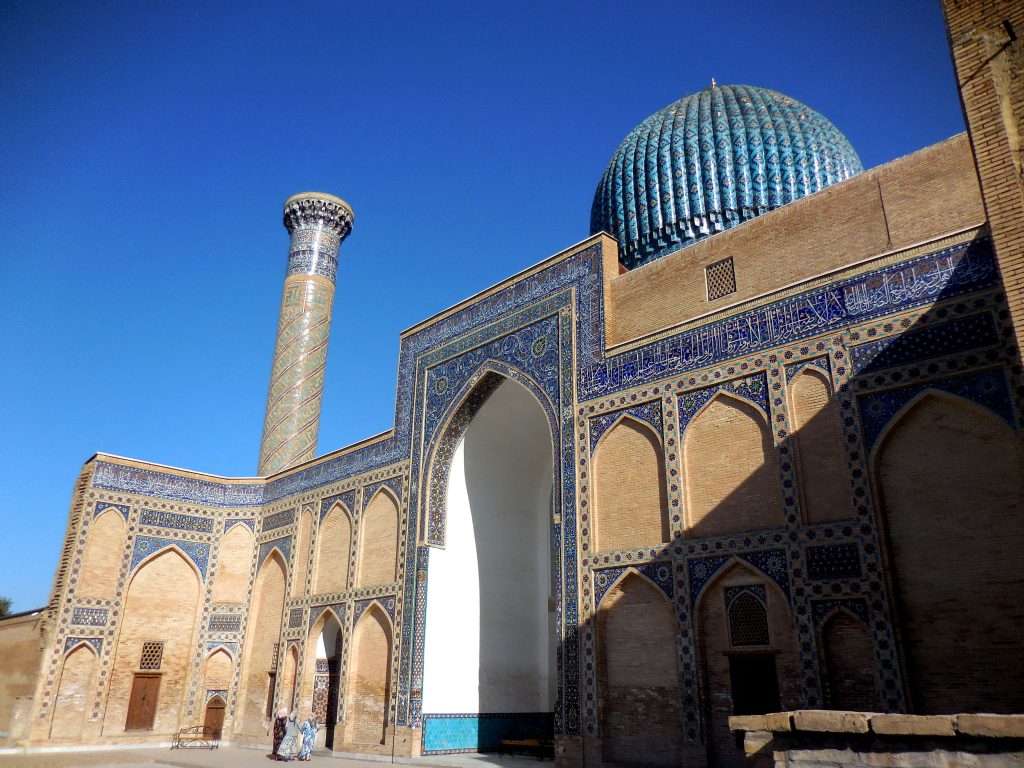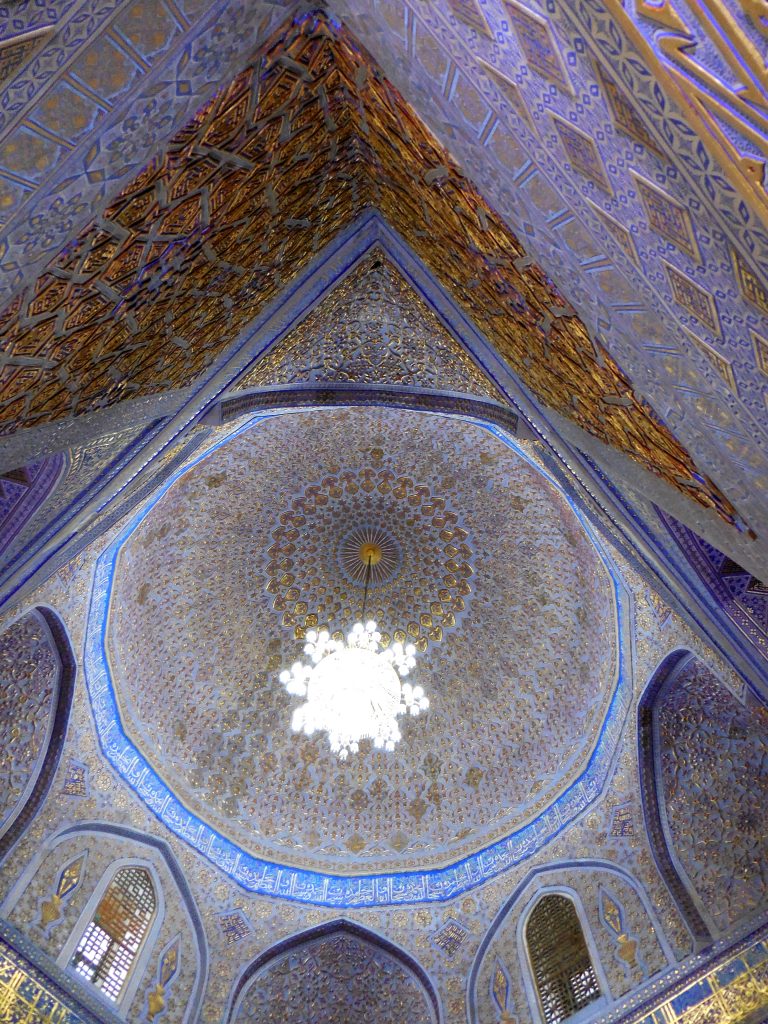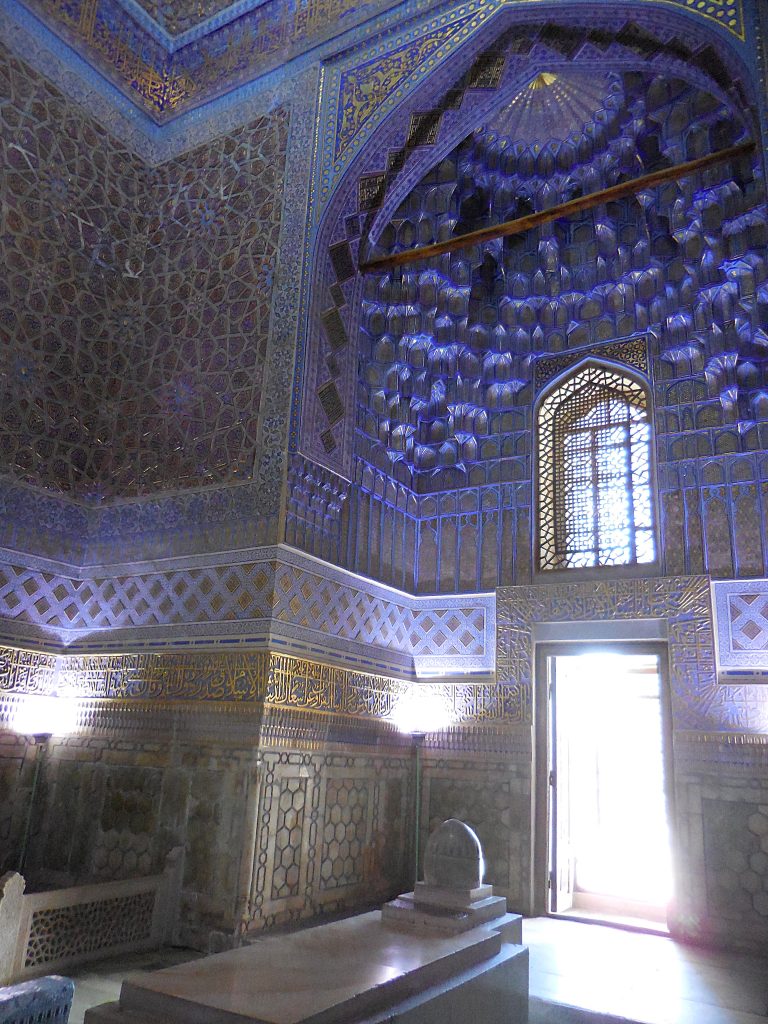Mausoleum Gur Emir, Tamerlane’s tomb, Samarkand, Uzbekistan
Mausoleum Gur Emir, Tamerlane’s tomb, Samarkand, Uzbekistan

Not far from Registan Square, it stands the Mausoleum Gur Emir (the “tomb of the commander”) where Tamerlane, his sons and grandchildren rest. The order of construction of the Mausoleum departed from Tamerlane in person; not for himself, but for his nephew Mohammed Sultan, who died in battle in 1403 and successor to the throne; by the moment he was the first child of his eldest son.
The mausoleum, with a base of 79.5 x 51.7 meters, includes a Madras and a Sufi khanaka, a place of spiritual retreat. The entire inner courtyard was surrounded by arches supported by pillars and minarets of double order at the corners.
The beauty of the interiors has not come down to the present day: the richness of the decorative coating in gold and turquoise leaves the visitor with the nose up for all the duration of the visit. The architectural and decorative style is typical of the XV-XVI century. Inside the room where the sarcophagi are located, onyx panels on the walls are covered with blue decorations and golden lettering. The upper marble slabs take up these star motifs with girih (tiles of Islamic art with five tesserae for geometric decorations) up to the ceiling; joined in the corners on the walls with refined golden muqarnas.
The arches and the inner dome are decorated with cartouches in high relief, gilded and covered with floral motifs. Richly carved wooden doors were present, and the windows had stained glass in red, blue, purple, green, and yellow.
The sarcophagi and the crypt

Under the turquoise dome are the sarcophagi of Tamerlane, his sons Sharukh Mirza and Miranshah, the nephews Mohammed Sultan and Ulugbek, in addition to the sons of the latter. The major sepulcher belongs to the spiritual master of Tamerlane, Mir Said Baraka, at the feet of which the ruler wanted to be buried. The covers are made of marble, apart from that of Tamerlane, on which a black jade block was placed, by order of Ulugbek. Among them, a long stick with a ponytail at the top remains erect to protect the bodies from evil spirits.
The bodies are not inside the sarcophagi, but lie in an underground crypt; exactly under the tombstones. The Italian journalist Tiziano Terzani, who visited Uzbekistan immediately after the collapse of the Soviet Union, had the opportunity to visit the crypt: “The spirit of Tamerlane-this nomad who built a capital in which he never wanted to live and a big empty tomb just to impress His descendants-I think everything is in the anonymous tumulus of bricks and mud, in a crypt that for centuries remained inaccessible to visitors. ”
Terzani always reports how the Soviets wanted to break the ban on opening the mounds in the crypt to satisfy their scientific curiosity in finding out if Tamerlano had been really lame because of a wound in battle and if his nephew Ulugbek had been deposed with the severed head, as it is told. For centuries, a prophecy claimed that if Tamerlane’s sleep had been disturbed, an immense disaster would have fallen on the nation. The Uzbeks were terrified by the prophecy; then the Soviet archaeologists decided to go down to the crypt at night; exactly that one: the June 21, 1941. Well the two questions were answered positively; but that same night the Nazi troops entered the URSS marching towards Leningrad: the beginning of the Second World War for the Soviets.
Legend on the Gur-Emir Mausoleum

The Chinese believes that jade has magical powers, for this reason, a panel of precious stone was present in the palace of the Chinese emperor. After the victory over the Mongols in 1425 near Ketmentepe, in the valley of the river Chu, Ulugbek receives two slabs of jade under unknown circumstances. In Samarkand, the artisans of the ruler fabricate the tombstone for Tamerlane with this treasure, under the order of Ulugbek.
In 1740, the khanate of Bukhara, which is part of Samarkand, was conquered by the Iranian shah Nadir, who orders to bring the jade stone to Meshed. In the capital of Iran, the stone was to be used as a slab for the floor and wall of a sacred building. However, during sleep, the spiritual teacher of Tamerlane, Mir Said Baraka, appears at Shah Nadir, who tells him to bring the stone back to its original place.
Scared, the next morning, Shah Nadir orders the return of the stone to Samarkand. During the journey, the slab falls river and splits into two unequal pieces. The artisans of the khanate still manage to reinforce the plates and store them in their designated place.
Address of the site.
For information on the Shah -i-Zindah site, click here.
Sources: A.V. Samarkand, the city and the legends, Davr Nashriyoti, Tashkent, 2014
Tiziano Terani, Buona notte, Signor Lenin, TEA, 1992, pp.231-232
Foto by Eva Zalesakova

Pingback: Samarkand the Great; History and tips. Uzbekistan, Central Asia | Erica Leoni
Pingback: Bibi-Khanym Mosque and legend, Samarkand, Uzbekistan.